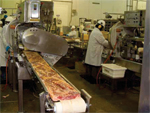
Farm-to-Fork Security
- By Ronnie Rittenberry
- Apr 01, 2011
Americans spend more than
$1 trillion on food each
year, and usually we get
what we pay for. Built into
the cost in most instances is the safety
and security of the various ingredients,
from the time they’re grown and prepared
to the moment they enter our
mouths. From that perspective, we enjoy
one of the safest food supplies in
the world. But the system’s not perfect.
Every year, some 76 million Americans
are affected by foodborne illnesses.
That number is a best guess by
the Centers for Disease Control and
Prevention, which says it cannot be
exact because many people do not go
to a doctor. What’s more certain is that
those illnesses annually result in an average
of 325,000 hospitalizations and
5,000 deaths. For the most part, those
foodborne fatalities are caused by naturally
occurring infections from bacteria
and parasites and not from sabotage.
But in recent decades, and especially
since 9/11, the deliberate contamination
of the food supply by terrorists has
been seen as a serious threat—one with
unique challenges requiring increased
food inspection, disease surveillance,
laboratory capacity, and, in general,
awareness by health professionals and
the public.
FSMA Measures
The Food Safety Modernization Act
signed into law by President Obama at
the beginning of January is designed to
meet some of those challenges. Among
other measures, the act increases the
number of inspections at all food facilities,
requires annual inspections of
high-risk facilities, and mandates that
the food industry develop plans that
identify hazards and implement the
right preventive measures. What this
latter part means, as ADT Security Services’
Hank Monaco notes, is that now
all food manufacturers and suppliers
have to, by law, have a safety plan in
place to quickly identify and limit possible
terrorist threats.
“If you think about it, this law really
encompasses the whole food supply
chain,” says Monaco, vice president
of commercial marketing for the Boca
Raton, Fla.-based company, a division
of Tyco International. “So, if you’re a
company that manufactures, processes,
distributes, or sells to the end user,
you’re going to be affected by this act,
so you’re going to really want to make
sure you’re paying attention to what the
requirements are.”
Where the food defense portions
of the law are concerned, Monaco
says ADT is helping companies integrate
their security elements in three
key areas: “One is ensuring they have
access control, starting with perimeter
protection and then controlling
access to certain spots that are really
critical points within the facility, using
video surveillance and other necessary
monitoring components; two is
alerts, having the proper equipment to
alert the facility and those who need
to know when something occurs; and
then three is auditing, which is showing
how you’re ensuring that you are
complying and doing what you say
you’re doing within FSMA.
“That third one is one of the big
components of the act because it does
give FDA the ability to come out and
audit, which requires you to really validate
what you’re doing, as opposed to
using merely internal auditing procedures,”
Monaco says.
In addition to expanding FDA’s access
to a food company’s records and
testing results, FSMA also enables
FDA to more effectively respond to a
foodborne illness outbreak by giving
the agency new authorities to order recalls
and shut down tainted facilities.
On the international level, the act
requires importers to verify the safety
of imported food and empowers FDA
to deny entry of any goods that lack
certification or adequate inspection by
U.S. inspectors.
FDA for Thought
In all, FSMA is the latest in a series
of federal actions taken since 9/11 to
strengthen the safety and security of
U.S. food. Part of the Bioterrorism
Act of 2002 contained a food safety
requirement that prompted FDA to require
companies in the food industry to
register with the agency and give it prior
notice of imported food shipments.
It also authorized FDA to administratively
detain suspect food, and it created
a requirement for food companies to
establish and maintain records for up
to two years of information that could
address credible threats.
In January 2004, the Bush administration
issued a directive calling for
a coordinated national approach to
countering threats to the food supply,
tasking the Department of Homeland
Security with leading national food
defense efforts while working with the
Department of Agriculture, the Department
of Health and Human Services
and EPA. Yet, despite increased
responsibility and concern, FDA did
not receive additional funding to support
food-related anti-terrorism activities
until FSMA came along, giving
that agency more resources and power
than it has had in its history.
When Sen. Richard Durbin (D-Ill.)
introduced FSMA in 2008, he said he
could envision the legislation serving
“as a starting point to bring our food
safety laws into the 21st century.” He
added: “It is the first step toward a
food safety system that is transparent,
risk- and science-based, accountable
to consumers, and dedicated to the
public health goal of preventing foodborne
illnesses.”
Durbin was right to see FSMA as
only a starting point.
For while it is the most comprehensive
federal action for food defense
to date, there are just too many links
along the supply chain where the industry
remains vulnerable.
As DHHS noted in guidance it issued
in 2005, “Contaminating food
does not require as much technical skill
and organization as does weaponizing
anthrax. Opportunities for access to
the food supply stretch from farms and
feedlots to restaurants and cafeterias.
For example, terrorists could introduce
an agent during the harvesting, packing,
shipping, delivery, or preparation
stage. Clearly, these acts are possible.”
The problem is that even after
FSMA measures are fully realized, the
possibility of such acts will still exist.
This article originally appeared in the April 2011 issue of Security Today.